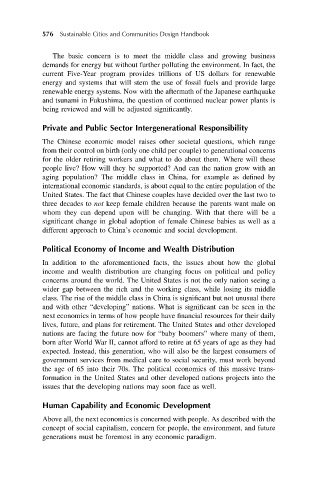Page 609 - Sustainable Cities and Communities Design Handbook
P. 609
576 Sustainable Cities and Communities Design Handbook
The basic concern is to meet the middle class and growing business
demands for energy but without further polluting the environment. In fact, the
current Five-Year program provides trillions of US dollars for renewable
energy and systems that will stem the use of fossil fuels and provide large
renewable energy systems. Now with the aftermath of the Japanese earthquake
and tsunami in Fukushima, the question of continued nuclear power plants is
being reviewed and will be adjusted significantly.
Private and Public Sector Intergenerational Responsibility
The Chinese economic model raises other societal questions, which range
from their control on birth (only one child per couple) to generational concerns
for the older retiring workers and what to do about them. Where will these
people live? How will they be supported? And can the nation grow with an
aging population? The middle class in China, for example as defined by
international economic standards, is about equal to the entire population of the
United States. The fact that Chinese couples have decided over the last two to
three decades to not keep female children because the parents want male on
whom they can depend upon will be changing. With that there will be a
significant change in global adoption of female Chinese babies as well as a
different approach to China’s economic and social development.
Political Economy of Income and Wealth Distribution
In addition to the aforementioned facts, the issues about how the global
income and wealth distribution are changing focus on political and policy
concerns around the world. The United States is not the only nation seeing a
wider gap between the rich and the working class, while losing its middle
class. The rise of the middle class in China is significant but not unusual there
and with other “developing” nations. What is significant can be seen in the
next economics in terms of how people have financial resources for their daily
lives, future, and plans for retirement. The United States and other developed
nations are facing the future now for “baby boomers” where many of them,
born after World War II, cannot afford to retire at 65 years of age as they had
expected. Instead, this generation, who will also be the largest consumers of
government services from medical care to social security, must work beyond
the age of 65 into their 70s. The political economics of this massive trans-
formation in the United States and other developed nations projects into the
issues that the developing nations may soon face as well.
Human Capability and Economic Development
Above all, the next economics is concerned with people. As described with the
concept of social capitalism, concern for people, the environment, and future
generations must be foremost in any economic paradigm.

